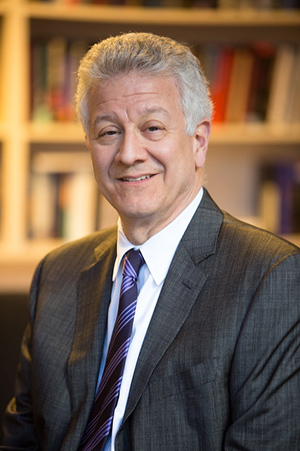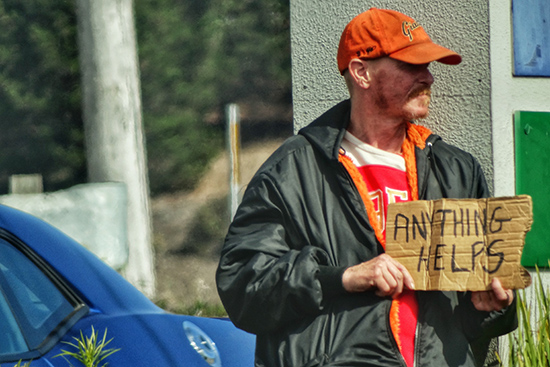Poverty Expert Sheldon Danziger to Give 2015 Bicknell Lecture
Economic inequality, not government programs, cause of stagnant poverty rate
A generation ago, in a now-famous speech to Congress, President Ronald Reagan pronounced antipoverty programs an abject failure.
“The government fought a War on Poverty, and poverty won,” he said.
Critics of the War on Poverty (legislation first proposed by Lyndon Johnson in his 1964 State of the Union address), including some presidential candidates, have echoed that view in recent months, as US Census Bureau figures show the poverty rate has remained relatively stagnant over the past 30 years. The latest report puts the poverty rate last year at 14.8 percent, 2.3 percentage points higher than in 2007, the year before the most recent recession. Median household income in 2014 was reported as $53,657—statistically the same as it was in 2013.
But while some look at those numbers as signs that government safety-net programs have failed, Sheldon Danziger, president of the Russell Sage Foundation, offers a different narrative based on recent social science research. With the benefits of economic growth going to the elite, not the average worker, he says, government programs are the main reason why the poverty rate has not climbed even higher.
“The conventional wisdom is that a rising economic tide lifts all boats. But it no longer works that way,” Danziger says. “The last 40 years have been a period of very slow wage growth and rising inequality.”
Disparities in income lead to disparities in health—a topic that Danziger, one of the country’s top experts on poverty and the social safety net, will explore tomorrow when he delivers the 2015 William J. Bicknell Lecture at the School of Public Health. His talk, Poverty, Public Policy and Public Health, will be followed by a panel discussion with Charles E. Carter, chief strategy officer at the Harvard University Center on the Developing Child; Molly Baldwin, founder and CEO of Roca, Inc., a nonprofit seeking to help young people transform their lives; and pediatrician Perri Klass, a New York University professor of journalism and of pediatrics. They will discuss the question: Should the mission of public health be the eradication of poverty?
Danziger, former Henry J. Meyer Distinguished University Professor of Public Policy at the University of Michigan Gerald R. Ford School of Public Policy and director of its National Poverty Center has written and edited a number of books on economic conditions, social programs, and poverty. He views public health as one way to improve the lives of the poor, touting Obamacare as a meaningful antipoverty program.
BU Today spoke with him recently about his views on poverty and public health:

BU Today: The US Census Bureau’s latest report shows little improvement for American families in the past year. Despite a falling unemployment rate, the median income is not budging. What’s wrong?
Danziger: The main problem, which has been going on for several decades, is that when the economy does improve, as it has for the past few years, the gains from economic growth have been uneven. In the past, when the economy improved, people got called back to work—there were benefits to the average worker. These days, wages don’t necessarily rise when the economy improves. In fact, people going back to work after the recession may earn less money than they did before. Many firms have not provided wage increases, and some are using technology to reduce hours and pay.
You’ve talked about income inequality worsening—that prosperity is no longer widely shared when the economy grows. Can you explain why that is?
We’re in a period of very slow wage growth. At the bottom, wages have not kept up with productivity growth, especially for workers without a college degree. Meanwhile, at the top, the inequality has become so extreme that it will take major tax reform to begin to reduce it.
At some point, incomes at the top began to explode. In 1965, the typical CEO of a major firm made 20 times what the average worker at his or her company made. That increased to 60 times in 1989—and it’s currently at 230. As just one example, consider Republican presidential candidate Carly Fiorina. She was paid more than $100 million during her short tenure as CEO at Hewlett-Packard, including a $65 million signing bonus and $21 million in severance pay.
So we have a situation where the increased productivity of the economy has been captured by the economic elite. This was not the environment that the War on Poverty era was launched in. In other words, poverty has remained high because of the failure of the economy to benefit the average worker—not because of the failure of government programs. Because the economy and poverty programs are working in opposite directions, you end up with a roughly constant poverty rate.
If inequality is the root problem, shouldn’t we be doing more to bring up the people at the bottom?
Certainly, yes. For starters, you could raise the well-being of those at the bottom through higher wages. Workers with a high school degree or less have been left behind: their wages adjusted for inflation are lower than they were 40 years ago.
We could make a significant dent in poverty through a number of public policies—raising the minimum wage, expanding subsidies for child care, increasing the earned income tax credit, launching a subsidized jobs program. All of these steps would help to bring up the bottom and have a modest effect on reducing inequality.
One of the newer policies that certainly has helped is the dramatic increase in insurance coverage under Obamacare. We have good examples of government programs bringing up the bottom; what we don’t have are very good examples of government bringing down inequality at the top.
Would you consider Obamacare an antipoverty program?
Yes. People who were uninsured or paying for their health care now have more money for other goods and services—food, clothing, shelter. It’s less likely that they’re being forced into bankruptcy because of unpaid medical bills.
Having access to health care means people are able to work more. If we discover a disease at an early stage and do something about it, that person can stay in good health and remain productive. It’s clearly the case that there are other government programs, such as food stamps and Medicaid coverage for poor kids, that have led to long-term improvements in health outcomes.
What about health disparities between the rich and poor or minorities and whites? Can government programs fix those?
They can certainly help. Consider what happened when Medicare was passed. There were millions of uninsured elderly people who were going to get covered by Medicare, and the Johnson administration made clear that no Medicare payments would go to segregated hospitals. This led to the eventual desegregation of hospitals throughout the South. There is now research documenting that because of this, large numbers of black women gave birth in hospitals instead of at home, and black infant mortality declined.
Health disparities are tied to poverty rates. Those at the bottom have lower life expectancies, higher unemployment. And the causation goes both ways–people in poor health are less likely to work.
Even within the white population, there are growing disparities by social class. Those disparities are much greater now than they were 30 years ago. There’s a new report by the National Academy of Sciences that suggests a correlation between rising income inequality and the increasing disparities in life expectancy. For males, the estimated life expectancy for 50-year-olds born in 1930 who were in the bottom 20 percent of income was 26.6 years more compared to 31.7 years more for those in the top 20 percent. That’s a five-year difference. Today, it’s 12 and a half years between the poorest and the richest 20 percent. Rising inequality is one of the reasons.
There will always be a bottom rung at elevated health risk. But the question is, can you reduce that risk? That’s the domain of public health, and it’s important.
The 2015 William J. Bicknell Lecture in Public Health is tomorrow, Wednesday, October 21, from 10 a.m. to 1 p.m. in the Hiebert Lounge at the School of Medicine Instructional Building, 72 East Concord St. The event is free and open to the public. The lectureship is named in honor of the late William J. Bicknell, founder and chair emeritus of the SPH international health department.
This BU Today story was written by Lisa Chedekel, She can be reached at chedekel@bu.edu.
